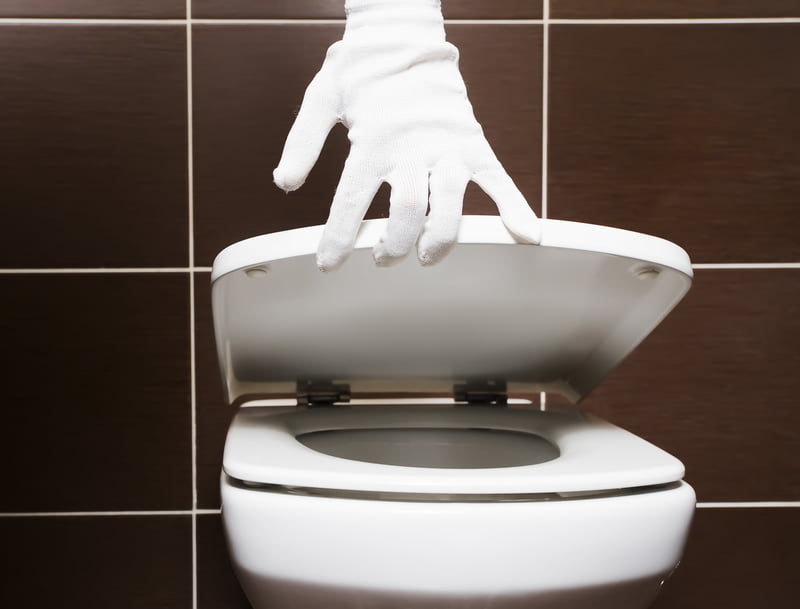
A lot of us don’t really think about our toilets as long as they’re running. But it’s actually pretty interesting how they can just hold water in the bowl of the toilet all the time without it leaking all over the floor. That is, in part, thanks to a wax ring that creates a tight seal between the base of the toilet and the sewer pipe beneath. Of course, nothing lasts forever, and when your toilet begins to near 30 years or so, it’s likely you’ll begin to see a little water leaking onto the floor. Alternatively, you might not see any water, but the toilet might feel loose or wobbly. So what now? How to replace wax ring on toilet?
You have a couple options. You can call in your friendly Calgary plumbing team. We’d be happy to schedule you an appointment for us replace the wax ring of your toilet. We can even replace the entire toilet, if you’ve decided to go with a newer model for increased efficiency or any other reason. Alternatively, you can just replace the wax ring yourself. The ring should cost you between $10 and $20 at your local hardware store, but you’ll need to do the heavy lifting yourself.
Turn Off the Water.
The supply line to your toilet should be right behind it between the bowl and wall. Turn it off to stop water flowing into the toilet. It should be easy enough to turn by hand, but if it’s been a few years, it may be sticky. Once the water is off, flush the toilet to remove as much water as possible from the toilet and down the sewer. You’ll need the tank and bowl as dry as possible, so once flushing isn’t doing anything, use towels or sponges to soak up as much water as you can. A wet/dry vacuum helps to speed this step along if you have one. Once the water is vacated, you can disconnect the water supply line from the toilet tank. This usually leaks a little, so have a bucket and a clamp handy to keep the line in place and not dripping on the floor.
Lift the Toilet.
The first step in removing the toilet is to take off the little protective caps covering the bolts at the base of the toilet. Use an adjustable wrench to remove the bolts and washer. If you’re unlucky, one or both sides may be rusted away. If that’s the case, and you can’t use your wrench to get the bolt off, you may need to cut it free using a hacksaw. Once the bolts are removed, gently rock and twist the toilet. The only thing holding it in place is what remains of the old wax seal and gravity, so it should come free fairly easily.
Find a friend and carefully remove the toilet. It can be hard to get a good grip on the ceramic, so work gloves may help. Remember to lift with your knees and keep your back straight. Set the toilet aside. This is a good time to roll up a rag and put it in the metal pipe fitting in the floor, called the toilet flange, to prevent sewer gases coming up. You’ll need to remove the rag pretty soon, so don’t shove it down the pipe.
Remove and Replace.
For the next step, you’ll need rubber gloves, a putty knife, and some sort of plastic bag or small trash can. This step can be a bit messy, so put your rubber gloves on. Use your putty knife to remove as much of the old wax ring as possible. Some of the wax will likely stick to the bottom of the toilet, and some to the toilet flange in the floor. As the wax is removed, you’ll be able to free the plastic portion of the wax ring from the toilet flange.
Before you replace the wax ring, you’ll need to completely clean and dry the flange, so take your time and do the job right. Once all the old wax has been removed, give the flange a quick inspection before moving on. If it looks dented or damaged, it’s time to call in your trusted Calgary plumber. If it looks alright, then it’s time to put the flange bolts back in place and stick the new wax seal on.
The wax seal will have a narrower piece of plastic on one side and a wider ring of wax on the other. The narrow plastic side goes into the flange, and the wider wax side is in contact with the toilet bowl. Most rings can be attached to either side, so pick whichever is more convenient for you. You’ll want stick the ring in place and use your hands to start forming the seal. Keep pushing and sticking until the ring doesn’t move if you try wiggling it.
Put the Toilet Back.
When you move your toilet back into its home, you need to get the tiny holes on the base of the toilet perfectly aligned with the flange bolts. This is tricky, but here are a few tips for making it easier. Use masking tape to create a straight line out from the bolts on either side, so that when you’re holding the toilet, you can still see, more or less, where the bolts are located. Secondly, have a friend or partner help you to support, steady, and secure the toilet into place over the bolts. REMEMBER to remove the rag that is preventing sewer gases from leaking into your room before putting the toilet into place.
Once the toilet is in position with both bolts in place, you’ll probably notice it’s a bit rocky. This is because the wax ring needs to be compressed into place. To do that, you (or preferably your heaviest friend) will sit on the toilet for a few minutes. This will create a good seal.
Finish Off by bolting the toilet down and replacing the bolt covers. Remember that porcelain doesn’t like to be held too tightly. So tighten by hand, and when it feels snug, that’s all you need. If you choose to use your wrench, be gentle. Reattach the water supply line, and finally turn the water main back on.
And that’s it! Replacing a wax ring isn’t particularly challenging, but it is time consuming, has some heavy lifting, and should be done with a friend (or family member). Remember that, if at any point during the process you feel like something is not quite right, you can just put down the tools and pick up your cell phone to call the Plumbing Paramedics at (403) 452-2911. We’ll be there to help you with your plumbing emergency as soon as we can!
Call us at (403) 452-2911 or Book Now an appointment.
When to Call a 24 Hour Plumber
Plumbing problems can strike at any time, often when you least expect them. A leaking pipe or a malfunctioning water heater can quickly turn into a full-blown emergency that needs immediate attention. Knowing when to [...]
Effective Drain Cleaning Techniques
Maintaining clean and clear drains is vital for the smooth operation of your plumbing system. Clogged or slow drains can lead to a host of issues, including unpleasant odours, slow water drainage, and even serious [...]
How Our Emergency Plumbers Handle Urgent Repairs
Plumbing emergencies can occur without warning, causing significant inconvenience and potential damage to your home. From burst pipes to sudden leaks, these issues require prompt and professional attention. Our emergency plumbers are ready to respond [...]






